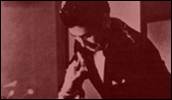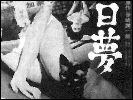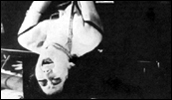Daydream
- Year
- 1981
- Original title
- Hakujitsumu
- Japanese title
- 白日夢
- Director
- Cast
- Running time
- 110 minutes
- Published
- 20 March 2001



by Jasper Sharp
Tetsuji Takechi is somewhat of a dichotomy to those of us trying to make sense of the wild and wonderful world of Japanese cinematic history. Primarily a theatre director who in the 1950s successfully staged adaptations of a number of experimental kabuki plays, he is also celebrated as being one of the founding fathers of the pinku genre of softcore sex films that began to flood into Japanese cinemas from 1964, the year of the Tokyo Olympics, onwards.
Takechi's first significant work was Daydream in 1964, a structureless succession of sexy set-pieces revolving around a series of fantasies in a dentist's waiting room. It was based on a short story which had appeared in the September 1926 issue of the magazine Chuo Koron. It was when this independently produced offering, along with a number of similarly salacious titles, was picked up for distribution by Shochiku, that nudity began to become a legitimate subject for onscreen portrayal in its own right. A hit in Japan, Daydream was released in the US in the same year (and later reissued in 1966 with additional footage shot by its distributor Joseph Green, director of the 1962 cult bad film The Brain That Wouldn't Die). As far as the public was concerned, the pinku eiga had arrived and Takechi was its leading light.
In 1981, after a more than a 15-year hiatus from filmmaking, the then 68-year old director returned with a full-blown, no-holds-barred remake of Daydream. From around 1975, hardcore pornography had been freely available throughout the States and most of Europe. Even though the proportion of films that fell under the "erotic" category in Japan then made up the highest proportion in the world, the depiction of genitals and unsimulated sex still required optical masking (and officially still does, unless foreign 'arthouse' productions - though in the case of video pornography, the mosaics are getting increasingly finer). The Japanese video release of Daydream is therefore missing a lot of the more pornographic footage that can be seen in the full-length version, at one time available on video in Holland, which sports a number of extremely explicit scenes filmed in lengthy close-up that leave little to the imagination.
As with the original, the basic set-up is a dentist's waiting room in which a young man and a young woman named Chieko sit. The girl is called into the surgery and as she succumbs beneath the nitrous oxide, she begins hallucinating a series of darkly sexual encounters in which she is molested by the dastardly dental surgeon. The boundaries between daydream and reality soon blur and the film soon drifts from eroticised scenes of clinical dentistry to scenes of clinically candid gynaecology, all laid down to the harsh twang of the traditional shamisen on the soundtrack.
The minimal narrative then heads through a succession of sequences that become as increasingly surreal as they are explicit, as Chieko is trussed up in a lengthy bondage session by the dentist in his apartment whilst the young man gazes on from behind a pane of glass, impotent to rescue her. She escapes and finds herself running naked through a shopping mall where the dentist, now kitted out in a PVC Dracula cape continues his pursuit. And so on.
Whereas the leading lady of the piece, Kyoko Aizome, made quite a name for herself with the same sort of material (later turning up in the straight-to-video Traci Lords vehicle Traci Takes Tokyo from 1986), Kei Sato who plays the dentist and partakes in a lengthy scene of unsimulated intercourse towards the end of the film, had a long and respected track record as an actor. A frequent collaborator with Oshima in his heyday in the 60s, his career led from early major appearances for Yasuzo Masumura (Irezumi, 1966) and Kaneto Shindo (Onibaba, 1964 and The Black Cat / Kuroneko, 1968) to the big-scale international co-production Hiroshima (1994, co-directed by Koreyoshi Kurahara and Roger Spottiswoode) and beyond. The press picked up on Sato's involvement and the resulting coverage brought audiences flocking in droves.
Takechi's motivation throughout his entire cinematic oeuvre remains dubious. A heady whiff of nationalism permeates his work. But aside from the question of whether he forged ahead with pornography as an alternate means of artistic expression or as a source of easy income, perhaps the most shocking thing about Daydream is that it is actually pretty well crafted within the confines of the XXX market. In any measure, it created enough of a splash to justify the director's further reprisal of the scenario in 1987 with Daydream 2 (Hakujitsumu Zoku). Takechi died the following year.